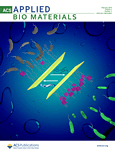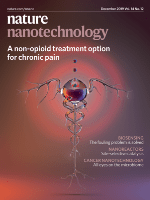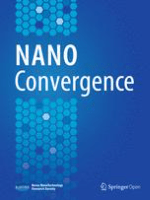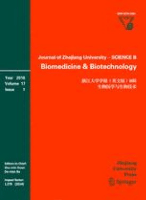
Advanced Science
Scope & Guideline
Bridging Disciplines, Advancing Science
Introduction
Aims and Scopes
- Nanotechnology and Materials Science:
The journal publishes significant advancements in nanomaterials, including their synthesis, characterization, and applications in areas like energy, electronics, and biomedicine. - Biotechnology and Medicine:
Research on the intersection of biotechnology and medicine is a core focus, particularly studies that investigate novel therapeutic strategies, drug delivery systems, and regenerative medicine. - Environmental Science and Sustainability:
Papers emphasizing sustainable technologies, environmental remediation, and the development of eco-friendly materials are prominently featured, reflecting the journal's commitment to addressing global challenges. - Electrochemistry and Energy Storage:
The journal highlights research on electrochemical systems, including batteries, fuel cells, and supercapacitors, focusing on materials and designs that enhance performance and sustainability. - Computational and Theoretical Studies:
Advanced computational methods and theoretical frameworks that aid in understanding complex systems and guiding experimental design are frequently included. - Biomedical Engineering and Regenerative Medicine:
Studies exploring engineering solutions for healthcare, including biomaterials, tissue engineering, and regenerative therapies, are significant aspects of the journal's scope. - Smart Materials and Devices:
Research on the development of smart materials and devices that possess adaptive functionalities for applications in sensors, actuators, and wearable technologies is a growing area of focus.
Trending and Emerging
- Artificial Intelligence and Machine Learning Applications:
The integration of AI and machine learning in experimental design, data analysis, and predictive modeling is increasingly prominent, indicating a shift towards computational methodologies in scientific research. - Sustainable and Green Technologies:
Research focusing on sustainability, including the development of environmentally friendly materials and processes, is on the rise, reflecting a global emphasis on addressing climate change and resource conservation. - Interdisciplinary Approaches to Health and Disease:
There is an increasing trend towards interdisciplinary studies that combine biology, materials science, and engineering to address complex health issues and develop innovative therapeutic strategies. - Nanomedicine and Targeted Therapies:
The exploration of nanotechnology for targeted drug delivery systems and personalized medicine is rapidly expanding, indicating a growing interest in the application of nanomaterials in healthcare. - Bioprinting and Tissue Engineering:
Research in bioprinting and tissue engineering is gaining momentum, particularly studies that focus on creating complex tissue structures for regenerative medicine and drug testing.
Declining or Waning
- Conventional Polymer Science:
While polymers remain important, the focus on traditional polymer science without integration into smart or functional applications is diminishing as researchers seek more innovative and multifunctional materials. - Basic Photovoltaic Research:
There is a noticeable shift away from publishing basic photovoltaic research towards more applied aspects, such as integration with nanotechnology and advanced materials for improved efficiency in solar energy. - Single-Use Biomedical Devices:
Research on single-use devices is decreasing as the field moves towards more sustainable and reusable biomedical technologies that align with environmental concerns. - Basic Inorganic Chemistry:
The emphasis on fundamental inorganic chemistry is lessening in favor of interdisciplinary studies that incorporate inorganic chemistry into broader applications, such as catalysis and energy storage.
Similar Journals

InfoMat
Elevating Knowledge in Materials Science with Every PublicationInfoMat is a premier open-access journal published by WILEY that serves as a vital resource for scholars and practitioners in the fields of materials science, materials chemistry, and related disciplines. Since its inception in 2019, this journal has rapidly ascended in academic stature, currently holding a prestigious Q1 ranking across multiple categories, including Electronic, Optical and Magnetic Materials, Materials Chemistry, and Surfaces, Coatings and Films, showcasing its significant impact and relevance. With a commendable impact factor and a comprehensive scope, InfoMat provides a platform for high-quality research that drives innovation in the materials domain, appealing to researchers, professionals, and students alike. The journal’s open-access model enhances visibility and accessibility of cutting-edge studies, fostering a collaborative and informed scientific community. Based in the United Kingdom, InfoMat continues to shape the future of materials research through its commitment to excellence and accessibility.

ACS Applied Bio Materials
Connecting Science and Technology for Biomedical AdvancementsACS Applied Bio Materials is a leading academic journal published by the American Chemical Society, focusing on the innovative intersection of bioengineering and materials science. Since its inception in 2018, the journal has established itself as a pivotal platform for disseminating impactful research within the fields of Biochemistry, Biomaterials, Biomedical Engineering, and Chemistry, often ranked in the top tiers of these categories. With an impressive impact factor, it holds a Q2 ranking in both Biochemistry and Biomaterials, and a prestigious Q1 ranking in Biomedical Engineering and miscellaneous Chemistry, underscoring its significance in advancing knowledge and practices across these disciplines. The journal’s editorial commitment to high-quality, peer-reviewed research ensures relevance and rigor, appealing to a diverse audience of researchers, professionals, and students keen to explore breakthroughs in bio-related materials technology. The access options enhance its visibility and reach, allowing for a broader dissemination of studies that drive innovation and collaboration in biotechnology and material sciences. Located in the heart of Washington, DC, ACS Applied Bio Materials serves as a crucial resource for advancing the future of healthcare, engineering, and materials research.

Gels is a distinguished, peer-reviewed journal published by MDPI, focusing on the innovative field of gels and their myriad applications across disciplines such as bioengineering, biomaterials, and organic chemistry. Since its inception in 2015, this Open Access journal has provided a platform for researchers to disseminate cutting-edge findings, enabling wider visibility and impact for their work. Based in Switzerland, Gels has firmly established itself within the academic community, achieving notable recognition as evidenced by its recent Q1 ranking in Polymers and Plastics, and multiple Q2 placements in related categories, demonstrating its relevance and importance in the field. The journal serves as a vital resource for professionals and scholars aiming to engage with the rapidly evolving research landscape surrounding gel technologies, making significant contributions to sustainable materials, drug delivery systems, and much more. With its commitment to Open Access, Gels ensures that research findings are readily accessible to all stakeholders, fostering collaboration and advancement in science and engineering fields.

Nature Nanotechnology
Transforming Ideas into Nanoscale Solutions.Nature Nanotechnology, published by NATURE PORTFOLIO, stands at the forefront of scientific innovation, focusing on the rapidly evolving field of nanoscience and nanotechnology. With an impressive impact factor and ranking in the top Q1 quartiles across multiple disciplines—including Atomic and Molecular Physics, Bioengineering, and Materials Science—this journal is a pivotal resource for researchers and professionals dedicated to advancing knowledge and applications at the nanoscale. Its diverse scope encompasses cutting-edge research that bridges disciplines, addressing critical challenges in engineering, physics, and biomedical fields. Although the journal currently does not offer an open-access option, readers can access a wealth of information that is vital for anyone involved in pioneering research and development efforts. With its robust editorial standards and a commitment to publishing high-caliber, groundbreaking work, Nature Nanotechnology serves as an indispensable platform for the dissemination of transformative ideas that will shape the future of technology and science.

Nano Convergence
Transforming the landscape of materials science through collaboration.Nano Convergence is a premier open access journal dedicated to the rapidly evolving fields of nanotechnology, materials science, and engineering. Published by SPRINGER, this journal has been at the forefront of interdisciplinary research since its inception in 2014, and is set to continue its journey until 2024. With an impressive impact factor and recognition as Q1 in both Engineering (miscellaneous) and Materials Science (miscellaneous) categories, Nano Convergence ranks among the top publications, listed as Rank #8 out of 307 in General Engineering and Rank #34 out of 463 in General Materials Science according to Scopus metrics. This journal provides a platform for researchers, professionals, and students to share pioneering studies that converge different disciplines within nanotechnology. With its commitment to open access, Nano Convergence ensures that cutting-edge research is readily available to the global community, fostering innovation and collaborative advancements in the field.

Energy & Environmental Materials
Exploring the Nexus of Energy Efficiency and Environmental StewardshipEnergy & Environmental Materials, published by WILEY, is an esteemed academic journal dedicated to pioneering research in the multifaceted domains of energy, environmental science, and materials science. Since its inception in 2018, this journal has rapidly established itself as a leading platform, holding a prestigious Q1 ranking across multiple categories including Renewable Energy, Sustainability, and Waste Management, reflecting its significant contributions to advancing knowledge in these critical areas. With a robust Scopus ranking that positions it in the top percentile for Environmental Science and Materials Science, it caters to a diverse audience of researchers, professionals, and students seeking cutting-edge findings and practical applications in energy efficiency and sustainable materials. This open-access journal facilitates the dissemination of innovative research and aims to bridge the gap between scientific exploration and real-world solutions for a sustainable future. The editorial team encourages submissions that explore both theoretical and practical aspects, ensuring that every publication not only contributes to the academic landscape but also drives impactful change in energy and environmental practices.

Frontiers of Chemical Science and Engineering
Pioneering Research for a Sustainable FutureFrontiers of Chemical Science and Engineering is an esteemed journal published by SPRINGER, dedicated to advancing the rapidly evolving domain of chemical engineering. Located in New York, USA, this journal provides a vibrant platform for disseminating groundbreaking research and innovative methodologies in the field. With an impressive Q1 ranking in Chemical Engineering and a Scopus ranking of 54 out of 273, it occupies a prominent position, reflecting its high impact and relevance among academic circles. Since its inception in 2011, it has fostered interdisciplinary collaboration, encompassing diverse topics such as process engineering, environmental sustainability, and nanotechnology, making it a vital resource for researchers, professionals, and students alike. The journal's open access policy further enhances accessibility, ensuring that cutting-edge research is readily available to a global audience. As the field continues to evolve, contributions to Frontiers of Chemical Science and Engineering play an essential role in shaping future advancements and empowering the next generation of engineers.

Frontiers in Materials
Connecting Researchers to Shape Tomorrow's Materials.Frontiers in Materials, an esteemed journal published by FRONTIERS MEDIA SA, is a leading platform in the field of Materials Science, with a notable impact factor placing it in the Q2 category of its discipline as of 2023. Since its establishment as an Open Access journal in 2014, it has fostered considerable academic exchange, allowing researchers from around the globe to share their innovative findings and insights. Based in Lausanne, Switzerland, this journal not only emphasizes high-quality peer-reviewed articles but also prioritizes rapid dissemination of research, as evidenced by its commendable Scopus ranking of #62 out of 196 in Materials Science (miscellaneous). By consistently striving to bridge the gap between academia and practical applications, Frontiers in Materials serves as an invaluable resource for researchers, professionals, and students seeking to delve into cutting-edge advancements and transformative applications in materials science.

Journal of Zhejiang University-SCIENCE B
Illuminating Insights in Biochemistry, Genetics, and BeyondThe Journal of Zhejiang University-SCIENCE B, published by ZHEJIANG UNIV PRESS, serves as a crucial platform for disseminating groundbreaking research across various fields including Biochemistry, Genetics, Molecular Biology, Medicine, Pharmacology, Toxicology, and Veterinary Science. With an impressive track record since its establishment in 2005, this journal continues to make significant contributions to scientific literature, ranking in the Q1 and Q2 quartiles as of 2023. This indicates its high relevance and impact within its respective fields, evidenced by its outstanding Scopus rankings, including a remarkable 4th position in Veterinary General and Pharmacology, indicating its authoritative voice in the scientific community. Researchers, professionals, and students are encouraged to explore this journal for insights and developments in innovative research, making it an essential resource for those dedicated to advancing the frontiers of science. The journal is accessible through traditional subscription models, ensuring that it remains a reliable source of high-quality research from China and beyond.

Portugaliae Electrochimica Acta
Empowering Researchers in the Electrochemical LandscapePortugaliae Electrochimica Acta is a distinguished journal dedicated to the field of electrochemistry, published by the SOCIEDADE PORTUGUESA ELECTROQUIMICA. With a notable ISSN of 0872-1904, this journal serves as a vital resource for researchers, professionals, and students interested in advancing their understanding of electrochemical processes. Though it is currently categorized in Q4 in the 2023 Electrochemistry rankings, the journal contributes significantly to the academic discourse from its base in Coimbra, Portugal. The journal's timeline spans actively from 2008 to 2025, ensuring a sustained engagement with emerging research. While the journal does not offer open access options, it remains an authoritative source noted for promoting innovative electrochemical research and fostering academic connections within the discipline. Researchers are encouraged to submit their findings and explore the latest contributions to this expanding field.